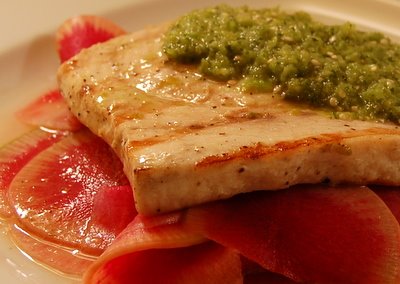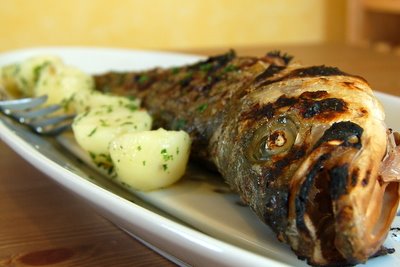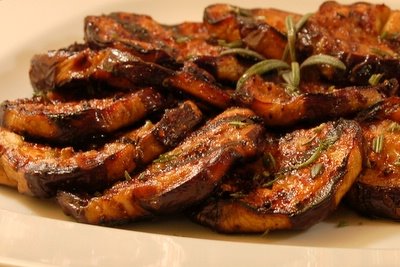This video is a June 2013 update to the original post.
If you've been reading this blog for the past couple of months (or even days), you probably came to expect something appetizing from it. Well, I have news for you folks. The next few posts might shatter your perception of Beyond Salmon for I am embarking on a "Parasites in Fish" series and there is no way I can make this lovely topic appetizing.
Why has a girl that almost flunked biology in high school got so interested in parasites? Sushi of course! Oh, and tartar. And ceviche, too. It’s amazing what I’ll do for raw fish. I've been buying tuna, salmon, and branzino from New Deal to serve raw for over a year and when I tried to go back to restaurant sushi recently, I realized that I've been spoiled for life. New Deal's fish is just better. The question is how much of a risk am I taking by serving raw fish at home?
If you are a squeamish person, new to cooking fish, I suggest that you don't read any further. I had a woman, in one of my classes, tell me that she wouldn’t eat fish again after my little lecture on parasites, and I don't want to be responsible for people stopping to eat fish purely because of squeamishness. If you are cooking the fish (with heat), no harm will come to you. I promise.
No mater how hard I looked, it was hard to find solid information on this topic. FDA was passionate about scaring the media, and the media was passionate about scaring the consumers. What I needed to find was someone passionate about parasites, and after 20 unsuccessful Google queries, I finally figured out what to search for: "parasitology Ph.D." Yes, there are people who care about parasites as much as I care about food and after a few e-mails, I had interviews lined up with 2 prominent parasitologists, Dr. Palm from Institute for Zoomorphology, Cell Biology and Parasitology in Düsseldorf, Germany and Dr. Gardner from Harold W. Manter Laboratory of Parasitology at the University of Nebraska.
First of all, let me say that parasitologists are some of the kindest and most patient people I have ever met in academia. They were willing to explain fish parasites in terms that even I could understand and painstakingly answered all my questions. I learned that there are over a hundred species of parasites that can be found in fish, but only 3 of them are potentially harmful to humans: Pseudoterranova decipiens (a.k.a. “cod worm” or “seal worm”), Anisakis Simplex, and Tapeworm.
Today, our special guest will be cod worm. I remember my first encounter with this critter about 4 years ago. As I unwrapped a cod fillet, I was greeted by a little worm squirming out of the fish. Good thing I heard about these worms before, or I would have thrown the fish in the trash and never set foot into that fish market (actually, it happened to be Whole Foods). In spite of my initial disgust (I am the kind of person who screams at the sight of an itsy-bitsy spider), I inspected the fillet, removed the worms and cooked the fish. It tasted just fine, and as you can see, I lived to tell the tale. These little worms are the pain of any fishmonger's existence because they freak the hell out of consumers. They are particularly common in white fish (cod, haddock, flounder, sole, and halibut), but I've also seen them in swordfish and monkfish. How often do you see them as a consumer? I cook fish at least 3 times a week and I'll see them a few times a year.
To prevent us, consumers, from having to look at these unsightly animals, the fish processors put all white fish through a process called "candling." They put the fillets on glass sitting over a lamp. This allows them to see through the fillet and remove any visible parasites. Think about this process as an airport inspection -- it makes everyone feel better, but it's not foolproof. On occasion, a few worms can escape the inspection and travel from the fish processing facility to your fishmonger and then to your kitchen. If this happens to you, don't panic. Remove the worms, and cook your fish the usual way. If you don't want to cook your fish after seeing the worms, I quite understand. Just don't go out of your way to ruin the fishmonger's reputation. The presence of worms has nothing to do with the freshness of the fish and I assure you that your fishmonger tried his or her hardest to protect you from this terrible experience. Last thing they want to happen is for you to find worms in your fish, but unfortunately this does happen sometimes.
What happens if you eat a cod worm? If it's dead, which it's bound to be if you cooked your fish to opaque state (or 140F), nothing at all happens. Even if you prefer your fish cooked a little less (120-130F) like I do, the odds of you eating a live worm are very slim. It would have to be a really hardy worm to survive those temperatures. If you are serving fish raw, and one of those guys manages to stay intact after you sliced the fish, and makes it all the way to your tummy intact, you are in trouble. Your stomach will eventually kill them, but since they originate in seals, they can get quite comfy in any mammal including us humans making the experience extremely unpleasant. As Dr. Palm puts it, “It is better not to eat them alive.”
What does this mean to serving fish raw or cured? That’s a topic that deserves its own post, so stay tuned.
You might also want to see these Frequently Asked Questions that people ask me about cod worms.
p.s. On a happier note… I’ll be away in California on vacation starting tomorrow, but I look forward to responding to all your questions and comments and telling you more parasite stories when I get back.
Parasites in Fish, Part 2 -- Anisakis and Tapeworm

 Remember that tomatillo
Remember that tomatillo 



 Surreptitiously, today’s dinner came out so well, that I just had to write about it. As of 6pm, all I knew was that I had swordfish in the fridge. The deciding moment came when I bit into a little green tomato looking thing called tomatillo in the
Surreptitiously, today’s dinner came out so well, that I just had to write about it. As of 6pm, all I knew was that I had swordfish in the fridge. The deciding moment came when I bit into a little green tomato looking thing called tomatillo in the 
 Sunday morning, I crawled out of bed to the smell of rising dough. When I walked into the study, Shel Silverstein's book was lying on my desk opened to...
Sunday morning, I crawled out of bed to the smell of rising dough. When I walked into the study, Shel Silverstein's book was lying on my desk opened to...
 A few months ago, a Beyond Salmon reader asked me why she couldn’t find a single eggplant recipe on my blog. I have nothing against eggplants, I assure you, but they have fallen out of favor with Jason way before I knew him, so I’ve avoided cooking them ever since we met. But my knight in shining armor has been conquering all the weird veggies at a frightening speed. There are so few left that I am not sure what I am going to do once he starts eating them all. It’s always been a bit of a sport for me to get him to eat asparagus, cauliflower, beets, and other denizens of the vegetable kingdom, and I will miss the challenge of inventing the most irresistible, mouth-watering dishes to get certain veggies on Jason’s good side?
A few months ago, a Beyond Salmon reader asked me why she couldn’t find a single eggplant recipe on my blog. I have nothing against eggplants, I assure you, but they have fallen out of favor with Jason way before I knew him, so I’ve avoided cooking them ever since we met. But my knight in shining armor has been conquering all the weird veggies at a frightening speed. There are so few left that I am not sure what I am going to do once he starts eating them all. It’s always been a bit of a sport for me to get him to eat asparagus, cauliflower, beets, and other denizens of the vegetable kingdom, and I will miss the challenge of inventing the most irresistible, mouth-watering dishes to get certain veggies on Jason’s good side? After sprinkling parmesan on the Swiss chard, and tossing the carrots with butter, I grabbed my media pass and re-entered my kitchen in a capacity of a journalist. My mission was to document the
After sprinkling parmesan on the Swiss chard, and tossing the carrots with butter, I grabbed my media pass and re-entered my kitchen in a capacity of a journalist. My mission was to document the  7 1/2 minutes later we were closely studying the finished steak like a team of doctors and fretting that its temperature was a tad too high (130F instead of our intended 120F). The 3 bites in the thicker part that came out medium-rare were excellent, but the rest of the steak that came out medium was on the dry side.
7 1/2 minutes later we were closely studying the finished steak like a team of doctors and fretting that its temperature was a tad too high (130F instead of our intended 120F). The 3 bites in the thicker part that came out medium-rare were excellent, but the rest of the steak that came out medium was on the dry side. 